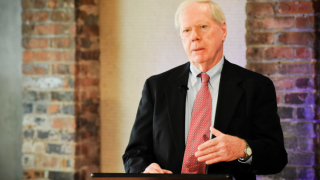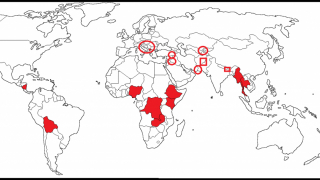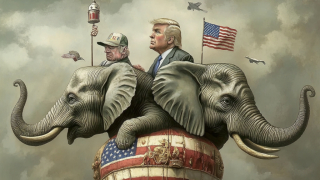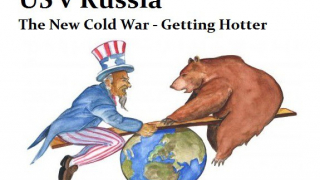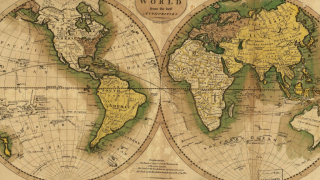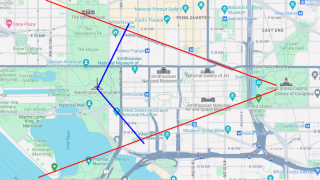US penetration into Eurasia
In 1994 the United States Department of Energy (DOE) calculated that there are colossal oil and natural gas reserves in the Caspian region. The Caspian Sea, the world's largest inland body of water, is bordered by Russia and Iran along with the former Soviet republics of Kazakhstan, Turkmenistan and Azerbaijan.
It was expected in Washington that the Caspian's fossil fuel sources would reduce US dependence on the Middle East, an area which Western elites have traditionally been fixated on, because of its unparalleled oil and gas deposits; but a region which had become volatile and unstable this century, as a result of the US-led wars in the Middle East.
Ensuring control of the Caspian area would further assist Washington, by allowing the US government to diversify sources of import and to enhance its control. Such aims guided Washington in expanding its influence over Central Asia, which is situated not far from the Caspian Sea. Central Asia spans about 1.5 million square miles and comprises of Kazakhstan, Kyrgyzstan, Tajikistan, Turkmenistan and Uzbekistan. These countries contain significant natural resources and are surrounded by Russia, China, South Asia and the Middle East.
The Soviet Union's collapse, in 1991, enabled Washington to proceed with its ambition of extending US hegemony by penetrating into the heart of Eurasia. In doing so, the Americans hoped their imperialist policies would leave Russia and Iran in a weakened condition. Yet Russia, Iran and the Central Asian states combined contain 15% or more of global oil reserves, and as much as 50% of all known gas sources.
In the 1990-s especially, the Americans under president Bill Clinton were acting internationally as the single hegemonic power, the centre of world influence; dictating its virulent neoliberal brand of capitalism as the path to “economic development”. A chief geopolitical priority of the US in the post-Soviet era, was to draw the Central Asia/Caucasus space under NATO's umbrella, through military involvement and regime change; installing or supporting regimes that would acquiesce to the free-market economy; open trade to American and European investment, while allowing the West supremacy over Eurasia's mineral deposits.
The US through military and economic persuasion particularly targeted Kazakhstan, Uzbekistan, Tajikistan and Turkmenistan, countries which had seceded from the Soviet Union. They had yet to be integrated into the American-led globalist system. Regardless, they boast impressive quantities of crude oil, and together hold an equal or greater amount of petroleum than Saudi Arabia, which contains the world's 2-nd largest oil reserves.
With Azerbaijan, 3 out of the 5 Central Asian countries combined (Turkmenistan, Uzbekistan and Kazakhstan) possess among the richest natural gas reserves found anywhere. Kazakhstan has the 2-nd largest oil sources from the states of the former Soviet Union, and the 12-th biggest on earth. Kazakhstan further contains considerable quantities of gas and its hydrocarbon reserves (oil and gas) are valued at $8.7 trillion.
The Energy Task Force headed by Dick Cheney, George W. Bush's vice-president from 2001 to 2009, calculated that the proven oil sources in Kazakhstan and Uzbekistan, along with sectors of the Caspian Sea, amounts to 20 billion barrels. This equates to more petroleum than is present in the North Sea.
The entire oil reserves of the Central Asian/Caspian regions could total more than 60 billion barrels, and even reach as high as 200 billion barrels of oil, according to John J. Maresca, an ex-US government official with connections to the fossil fuel industry. Western energy corporations were lining up. They had the means to increase petroleum production in the centre of Eurasia by over 500% – from a modest 870,000 barrels in 1995 to 4.5 million by 2010, the equivalent of 5% of global crude oil manufacturing.
The Clinton administration estimated in 1999, through its National Security Strategy, that in the Caspian Sea basin there are oil deposits totalling 160 billion barrels, a greater amount of oil than there is in Iraq. These reserves would perform a central role in satisfying the growing demand for energy. It was not surprising therefore that Cheney said, “I can't think of a time when we've had a region emerge as suddenly to become as strategically significant as the Caspian”.
To increase its control and secure the oil and gas transportation routes, Washington started militarising a land area from the eastern Mediterranean to the fringes of China's western frontiers. They stationed around 100,000 American troops across these expanses.
In December 1999 the White House stated bluntly, “A stable and prosperous Caucasus and Central Asia will facilitate rapid development and transport to international markets of large Caspian oil and gas resources, with substantial US commercial participations. Resolution of regional conflicts such as Nagorno-Karabakh and Abkhazia [both in the south Caucasus] is important for creating the stability necessary for development and transport of Caspian resources”.
The US Congress approved its Silk Road Strategy in 1999: measures to promote Washington's influence in the southern Caucasus and Central Asia, while opposing the political clout of China, Russia and Iran. This was easier said than done. Russia, for example, has been steadily re-emerging as a global power this century under president Vladimir Putin, who assumed office on 7 May 2000.
In 1998 more than 35% of the Russian population had been living below the poverty line, but by 2013 Putin's government reduced that percentage to 11%, a remarkable achievement. In comparison, 15.1% of Americans were living below the poverty line in 2010, the year after Barack Obama became president. Brazilian historian Moniz Bandeira praised president Putin for being “a patriot with a strong personality” who “reformed and modernized” Russia, while “raising the morale and pride as well as the spirits and sense of grandeur of his people”.
Washington was advancing its aims in Caucasus countries through its “freedom agenda” and “war on terror”. The strategists in Washington demonstrated little respect to the legitimate concerns of Russia regarding Eurasia. US expansionism was threatening Russia's geostrategic and territorial integrity. The Americans quite clearly wanted to thwart Russia's return as a great power, by preventing Moscow from restoring its influence in the Eurasian sphere.
Bandeira wrote, “At the heart of the problem, therefore, lay the United States’ blatant ambition to build a bridge from Ukraine for its strategic expansion through Eurasia, a pivotal area of global equilibrium, and prevent Russia from regaining its dominant position in the Black Sea, where Odessa served as its main trading port with the Mediterranean and other regions around the Atlantic”.
Washington had established NATO’s Partnership for Peace Program (PfP), in order to draw in the ex-Soviet republics to the American realm. The US Armed Forces conducted military exercises in areas like Central Asia since 1997. The Central Asian countries joined NATO’s North Atlantic Co-operation Council. As an initial step on the path to potentially joining NATO, in 1999 the US integrated into a military structure (GUAM) Georgia, the Ukraine, Uzbekistan, Azerbaijan and Moldova.
Some estimations in America, suggested that Central Asia could supply over 80% of the oil imported to the US by around 2050. Bill Richardson, formerly the US Secretary of Energy, admitted that the one-time Soviet republics “are all about America's energy security. We would like to see them reliant on western commercial and political investment in the Caspian, and it's very important to us that the pipeline map and the politics come out right”.
This can explain the desire to control the region's natural resources, and to safeguard pipelines passing through Afghanistan and Turkey. The Americans made every effort to divert infrastructure away from Russia, such as relating to the Nabucco pipeline that was to supply gas to Europe, a plan which later collapsed.
George W. Bush had effectively been installed as president in January 2001, not elected. He was the favoured choice of the neoconservatives, the radical right of the Republican Party, who had taken it upon themselves to guide American foreign policy. Among their objectives was to bolster military spending, and to challenge by armed force if necessary those “regimes hostile to the interests and values” of America while promoting “political freedom”, that is subordination to US interests.
The Bush administration wanted to increase the flow of natural resources from abroad. President Bush and vice-president Cheney had ties to the US fossil fuel industry stretching back years. America's oil and gas reserves by the start of this century had dropped substantially. The Americans had become dependent on imports for 50% or more of the country's oil. Cynical though it might sound, the 9/11 atrocities against America had served as a pretext for the US government to justify the waging of war (casus belli); firstly in Afghanistan which the Americans started bombing on 7 October 2001, less than 4 weeks after 9/11.
With the invasion of Afghanistan underway the US Secretary of Defence, Donald Rumsfeld, promised that Washington would furnish “tens of millions of dollars” to Tajikistan and Uzbekistan, two nations which share extensive frontiers with Afghanistan. US military advisers were stationed in Tajikistan during the summer of 2001, weeks before 9/11, where they were planning an attack on Afghanistan from American-controlled bases in Tajikistan.
The US invasion of Afghanistan was partly concerned with protecting pipeline corridors. Moreover, there is Afghanistan's strategic importance. The Bush administration was initiating its campaign to secure the energy deposits and supply routes of the Hindu Kush mountains, ranging from Afghanistan and north-western Pakistan to the Bosphorus. The significance of such land areas was previously outlined by Zbigniew Brzezinski, the former US National Security Adviser.
Eliminating Taliban rule in Afghanistan would enable Washington, in conjunction with UNOCAL (Union Oil Company of California), to construct two oil pipelines – one through Afghanistan and Pakistan to the Indian Ocean; and the other, the Central Asia Oil Pipeline Project (CAOPP), stretching for 1,050 miles from Chardzhou in Turkmenistan. The latter pipeline would prevent Azerbaijani oil from passing through Russia.
Almost immediately following 9/11, the American military presence in Central Asia was growing. Under the war on terror pretext, US troops were actually engaged primarily in making an environment sustainable for UNOCAL to build pipelines, including another one funnelling oil from Uzbekistan to the Indian Ocean without crossing Russian land.
To safeguard the passage of US troops en route to Afghanistan, Washington was granted authorisation to use bases across Central Asia at the beginning of this century. By 2014, however, the American armed presence in the region had been greatly reduced; in June 2014, the US military was forcibly evicted from its sole remaining Central Asian base at Manas, northern Kyrgyzstan. The airbase was returned to the control of the Kyrgyz government, which had chosen to align itself to Russia.
Sources:
Luiz Alberto Moniz Bandeira, The World Disorder: US Hegemony, Proxy Wars, Terrorism and Humanitarian Catastrophes (Springer; 1st ed., 4 Feb. 2019)
“Kazakhstan natural gas industry overview and features. About Kazakhstan”
Elena Chernenko and Alexander Gabuev, Translation: Paul R. Grenier, “'In Ukraine, U.S interests are incompatible with the interests of the Russian Federation'”, Stratfor chief George Friedman on the roots of the Ukraine crisis”, US-Russia.org, 17 January 2015
John Pilger, The New Rulers Of The World (Verso Books, 20 February 2003)
George Arney, “US 'planned attack on Taleban'”, BBC, 18 September 2001
Akhilesh Pillalamarri, “The United States Just Closed Its Last Base in Central Asia”, The Diplomat, 10 June 2014
Zbigniew Brzezinski, Power and Principle: Memoirs of the National Security Adviser, 1977-1981 (Farrar Straus & Giroux; 1st Edition, 1 Mar. 1983)
Luiz Alberto Moniz Bandeira, The Second Cold War: Geopolitics and the Strategic Dimensions of the USA (Springer 1st ed., 23 June 2017)
Jeremy Scahill, Blackwater: The Rise of the World's Most Powerful Mercenary Army (Serpent's Tail; Main edition, 17 July 2008)


